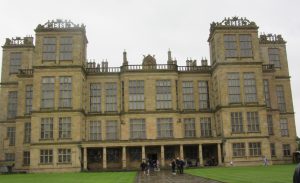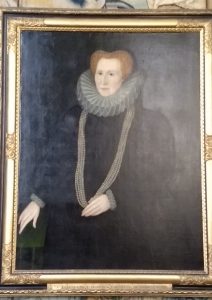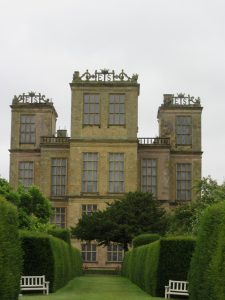Inspired by a recent cnn.com article about how to fund a British stately home or manor house in modern times, I thought I would write about how my three favorite houses have handled this. For Wollaton, see here for Longleat, see here. Finally, I look at Hardwick Hall.

Hardwick Hall
Hardwick Hall represents the pinnacle of a building career that lasted decades and included Old Hardwick Hall and Chatsworth, along with buildings at Bolsover, Sheffield, Tutbury and Worksop. My friend Robert Smythson provided the plans for the building, but the idea of Hardwick was probably swirling in Bess’s active mind for years, waiting for the right moment when she finally had freedom and control over her fortune.

Bess, Builder of Hardwick
Bess rose from relative obscurity to become one of the best known and richest women in England. Her six children were the beginning of her legacy, which continues today through the lined of the Dukes of Devonshire, Somerset, and Norfolk, as well as the Earl of Pembroke. Her granddaughter Arbella, the daughter of Bess’s daughter Elizabeth and Charles Stuart, had a significant claim to the throne following Queen Elizabeth I, but was ultimately pushed aside in favor of King James I.
Upon Bess’s death, Hardwick was left to her second and favorite son William, while her eldest son Henry inherited Chatsworth. Several generations later, Chatsworth became the principal residence for the Cavendish family. This meant that Hardwick Hall remained largely unoccupied since the 17th century and remains mostly unaltered or updated. The interior of Hardwick Hall remains one of the best examples of Elizabethan architecture and style.
Care of Hardwick Hall was taken over by the National Trust in 1959, and since then the Trust has worked to maintain and conserve the treasures both within and without this beautiful house, while keeping it open for visitors. The National Trust is a non-profit, charity organization tasked with the job of “keeping places special for ever, for everyone.” The National Trust manages and maintains over 500 houses, buildings, gardens, and areas of interest and natural beauty across Great Britain.

Old Hardwick Hall
Interestingly, Hardwick Hall was built just steps from Bess’s childhood home of Old Hardwick Hall. Over the years, Bess added on and modified this building until she abandoned it in favor of starting afresh with the new Hall. Old Hardwick Hall is owned and managed by English Heritage, another charity which oversees many historical sites in Britain. Chatsworth, the current residence of the Duke and Duchess of Devonshire, is still privately owned by Bess’s descendants and is also open for public viewing.

One of my favorite views
This series has looked at three different houses, all with different solutions to the same problem: that of affording the upkeep of a great estate in today’s economy. In two cases, Wollaton and Hardwick, the families chose a different house for their primary residence and gave others to charities or local government to rid themselves of the burden. Only Longleat remains in private family ownership. But all three are open to visitors who want to explore the past and share their history. If you get the chance to visit any of these, or any one of the many historical homes open in Great Britain, I urge you to take it. Whether you, like me, go to see the houses themselves, or the art and tapestries they contain, or the formal gardens surrounding them, I think you will agree that they are a beautiful piece of history.

























